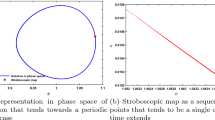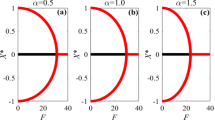Abstract
This article takes a class of strongly nonlinear Duffing systems with fractional-order terms as the research object, studying their main resonance and conditions for chaos under single-frequency excitation. The approximate analytical solution of the main resonance of the system under single-frequency excitation is obtained by the multi-scale method. The approximate analytical solution is utilized to construct the steady-state motion's amplitude–frequency response equation, and Lyapunov's first method is used to determine the constant solution's stability condition, which is then used to analyze the steady-state motion's stability. The system is examined by using the Melnikov method to identify the circumstances that would appear to result in a transverse intersection of heterodox orbits and the onset of chaos in the system. The amplitude–frequency characteristics of the total response of the system at various excitation frequencies are investigated in numerical simulations using analytical and simulation methods, respectively, and the system makes a comparison of amplitude–frequency curves, confirming that the numerical results and results achieve a consistent trend. The effects of nonlinear stiffness coefficients, excitation amplitude, fractional-order differential term order and fractional-order differential term coefficients on the system's amplitude–frequency response are each examined in turn. A numerical investigation of the effects of system parameters on chaotic motion is then conducted using many kinds of diagrams .
















Similar content being viewed by others
Data availability statement
All data generated or analyzed during this study are included in this published article.
References
P Prommee, P Pienpichayapong, N Manositthichai et al AEU: Archiv fur Elektronik und Ubertragungstechnik: Electronic and Communication. 128 (2021)
A Z Mohammad and A K Ali Journal of Computational and Applied Mathematics. 438 1 (2024)
D Yan, W Wang, Q Chen Chaos Soliton Fract. 133 (2020)
P Y Xiong, F E Alsaadi et al Chaos, Solitons and Fractals.144 (2021)
S Dadras, H R. Momeni Physica A: Physica A. 389 2434 (2010)
L Chaib, A Choucha and S Arif Ain Shams Eng J. 8 113 (2017)
S P Nangrani S S Bhat Asian J Control. 20 403 (2018)
G Tzounas, I Dassios, M A Murad et al Ieee T Power Syst. 35 4622 (2020)
S A Hosseini Scientia Iranica. 20 1464 (2013)
A Kimiaeifar and A R Saidi Solution & Fractals. 42 2660 (2009)
K Zhao J Li Chinese Journal of Physics. 77 1796 (2022)
K B Kachhia, B Krunal Partial Differential Equations in Applied Mathematics. 7 (2023)
P Perdikaris G E Karniadakis Ann Biomed Eng. 42 1012 (2014)
A Raza, M Farman, A Akgül et al Aims Bioeng. 7 194 (2020)
D Kumar D Baleanu Front Phys-Lausanne. 7 81 (2019)
M A Abdou Indian J Phys. 93 537 (2019)
D Guo, G Yang, X Feng et al J Energy Storage. 30 (2020)
S Sarwar and M M Rashidi Wave Random Complex. 26 365 (2016)
H M Baskonus, T Mekkaoui, Z Hammouch et al Entropy-Switz. 17 5771 (2015)
A Yousefpour, H Jahanshahi, J M Munoz-Pacheco et al Chaos Soliton Fract. 130 (2020)
Z Wang and X Huang H Shen Neurocomputing. 83 83 (2012)
K Zhou, Z H Wang, L K Gao et al Chinese Phys B. 24 (2015)
Q Zhou, J Gao, Z Wang et al Ieee T Geosci Remote. 54 1905 (2015)
F H Li and Z F Li Earthquake Science. 36 81 (2023)
Y Wang, Y Ning and Y Wang Energies. 13 5901 (2020)
Acknowledgements
The project is supported by the Fundamental Research Program of Shanxi Province (20210302123207 and 20210302124009), National Natural Science Foundation of China (U22A20188), Shanxi Province Merit-based Funding Project for Scientific and Technological Activities of Returnees Studying Abroad (20230032),Shanxi Patent Transformation Special Plan Project(202201006 and 202202032), Taiyuan University of Science and Technology Joint Training Demonstration Base for Graduate Students (JD2022002), Taiyuan University of Science and Technology Graduate Innovation Project (BY2022004) and the Coordinative Innovation Center of Taiyuan Heavy Machinery Equipment,2022 Huai'an "Huaishang Talent Program" innovation and entrepreneurship team.
Funding
Funding was provided by University-level graduate innovation Project
Author information
Authors and Affiliations
Corresponding author
Ethics declarations
Conflict of interest
The authors declare that they have no conflict of interest.
Additional information
Publisher's Note
Springer Nature remains neutral with regard to jurisdictional claims in published maps and institutional affiliations.
Rights and permissions
Springer Nature or its licensor (e.g. a society or other partner) holds exclusive rights to this article under a publishing agreement with the author(s) or other rightsholder(s); author self-archiving of the accepted manuscript version of this article is solely governed by the terms of such publishing agreement and applicable law.
About this article
Cite this article
Liu, J., Zhang, P., Gui, H. et al. Resonance study of fractional-order strongly nonlinear duffing systems. Indian J Phys (2024). https://doi.org/10.1007/s12648-024-03080-z
Received:
Accepted:
Published:
DOI: https://doi.org/10.1007/s12648-024-03080-z




